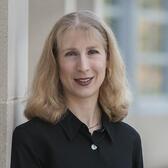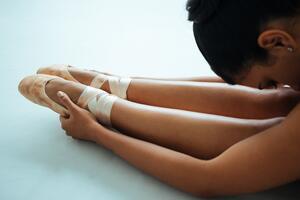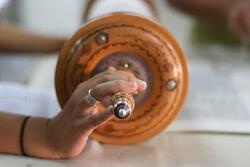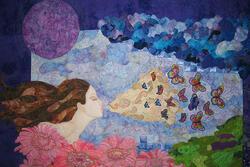Seamstresses, Shop Girls... and Ballet Dancers?
Ballerina stretching. Photo by Beto Franklin from Pexels.
When we think of the lives of Jewish immigrant families in early 1900s New York, we often envision tenements, factories, and lives of hard work. Ballet is not the first thing that comes to mind. But for some young Jewish girls, the ballet studio offered an alternative to the sweatshop or the department store, setting off more than a century of Jewish communal interest in dance.
In 1913, author Willa Cather profiled the Metropolitan Opera Ballet School for McClure’s Magazine. The goal of the school was to create an all-American corps de ballet for the Metropolitan Opera so that European dancers would not constantly have to be imported for lack of proficient Americans. Cather pointed out in her article that Metropolitan Opera Ballet salaries—fifteen dollars a week to start, eventually rising to twenty dollars—were competitive with the salaries of factory workers and even shop girls, and she wondered why more girls did not choose this path. Readers of the All-of-a-Kind Family children’s books about an early twentieth-century Jewish immigrant family in New York may remember that Ella, the eldest daughter in the family, took a job as a chorus girl for a while, in part because she could earn so much money as a dancer.
To ballet teachers, directors, and choreographers, talent mattered more than economic, ethnic, or religious background. A Morning Oregonian reporter who observed a class in February 1913 noted that Malvina Cavallazzi, the Italian ballerina who directed the Metropolitan Opera Ballet School, told student Maggie Reilley (presumably Irish) to look at Esther Rosenberg (presumably Jewish) for the correct form. There was no ethnic discrimination in the ballet studio (though it is worth noting that there was an unquestioning racist prejudice against ballet dancers of color that still reverberates today). When, as a 1916 publicity stunt for a New York performance, Anna Pavlova auditioned students for a free ballet class, girls of every conceivable background, including Jewish girls from immigrant families, showed up as equal supplicants. As the New York Evening World reported on October 27, “Every girl who appeared at the Hip[podrome] yesterday was so absolutely certain she could shake a wicked toe that Pavlova and her associates found the work of making selections very difficult.” The growing popularity of ballet in America, encouraged by the glamour of European dancers like Cavallazzi and Pavlova, reduced the stigma of a life on stage just as dance started to become more accessible to the immigrant girls who might take dance class at a settlement house or attend vaudeville dance performances with their family and friends.
A small cadre of Jewish girls from immigrant families, though generally not the very poorest, began taking ballet classes with Michel Fokine, one of the most influential figures of early twentieth-century ballet. Starting in 1927, first-generation immigrants Ann Wilson Wangh (then Anna Wolfson) and her cousin Shirley trekked to Manhattan several times a week from East Orange, New Jersey, accompanied by their mothers, who paid for the lessons one at a time and arrayed themselves on either side of the open door to watch. These Jewish ballet mothers sacrificed so much money and time that the children were afraid to complain about boredom or pain, but they were also entranced by what they were learning. Wangh recalled, “When I was ten years old, my Wednesday class with Michel Fokine became the center of my life. All the other days of the week seemed...tedious.”
For many Jewish mothers sending their children to Fokine, the long hours, high tuition, and six dollars per pair of pointe shoes paid off, according to Wangh’s recollections. Mrs. Koreff’s daughter Nora (Kaye) became an American Ballet Theatre star; Mrs. Feldman’s daughter Rose danced with the Metropolitan Opera Ballet; Mrs. Weiskopf’s daughter Miriam performed with Fokine’s own company; Mrs. Eisner’s daughter Betty (Bruce) became a tap dancing Broadway star; and Mrs. Wolfson’s daughter Anna became an American Ballet Theatre soloist. This highly unusual level of achievement was not what all, or even most, ballet students were looking for, but for these Jewish families the success of their daughters contributed to their upward mobility in America. And for generations of American Jewish girls thereafter, ballet classes became as much a rite of passage as bat mitzvahs.
The ubiquity of ballet class for American Jewish girls has shown up in a variety of ways over the last century or so, including, once again, in children’s literature. Ferida Wolff’s 1989 book Pink Slippers, Bat Mitzvah Blues pitted bat mitzvah lessons against ballet class, a not uncommon scheduling conflict, while Robyn Bavati’s 2013 book Dancing in the Dark tells the story of Ditty Cohen, a talented Orthodox girl forced to make a more serious choice between her family and her desire to become a professional ballerina.
The rise of ballet class within Orthodox Jewish communities in recent years illustrates the powerful pull of ballet for girls—and in virtually all Orthodox communities, ballet is only for girls—and their parents. Some Orthodox girls have long enrolled at regular community studios, though usually with self-imposed restrictions, such as not taking classes or performing on the Sabbath, or not performing at all in front of mixed-gender audiences. But the interest in ballet has grown to the point that in major centers of American Orthodox life there are now studios exclusively serving an Orthodox clientele. At first glance, the websites for these community dance studios look like those of any others. They provide class schedules, list tuition policies, and describe the facilities. Further investigation, however, reveals more unusual features. After all, how many dance studios come with rabbinical endorsements? Or, like the Jewish Center for the Performing Arts in Brooklyn, promise “excellence in performing arts education in a kosher way”?
Several of these studios were founded by women with considerable ballet experience who came to Orthodox Judaism as adults. Michelle Penn of La Zooz Dance in Silver Spring, Maryland, danced with the Fort Lauderdale Children’s Ballet Theater and majored in dance at Northwestern, while Rivka Nahari of the Jewish Center for the Performing Arts in Brooklyn trained at the pre-professional program of Nevada Ballet Theater and continued dancing at the University of Nevada in Las Vegas. When these women became religiously observant, they made it their mission to provide opportunities for Orthodox girls and women to study ballet and dance.
Ballet schools like La Zooz, the Jewish Center for the Performing Arts, Bas Melech Performing Arts Center in Baltimore, and Inside Out Dance Academy in Monsey, New York, cater to their Orthodox clientele. Most of them use only instrumental music in the studio in order to avoid any potentially controversial lyrics, and both classes and performances are for women only. All of these studios are closed on the Sabbath and on Jewish holidays. Most hire secular teachers but in doing so carefully describe the Orthodox students as sheltered from mainstream culture and emphasize the need to stay away from any remotely suggestive music or movement. Most of the girls and parents see ballet as graceful and feminine, something that will underscore rather than undermine the girls’ gendered place in the community.
For more than a century, ballet class has not only interested American Jewish girls but also served their interests. During the early 1900s, at least some working-class Jewish girls from immigrant families found both artistic expression and upward socioeconomic opportunities in dance, while today Orthodox girls discover in ballet a meaningful extracurricular activity with traditions that can accommodate their own community values. Ballet is pretty Jewish. Who knew?
Melissa R. Klapper’s new book Ballet Class: An American History is now available anywhere books are sold. JWA readers can order it directly from Oxford University Press for a 30 percent discount by using the promo code AAFLYG6 at checkout.








Lovely article. I am a product of mid-century (20th)
Middle class ballet classes. A slightly gazunt 8 year old.... there was NO CHANCE of ever going on toe even as I got older. I then graduating to Modern Jazz .... better but no apparent future. However, it taught me grace, movement cultural appreciation and a lifetime of supporting the arts.
So at 72 I still use all those previous elegant movements as I keep my body healthy and a dedication to good posture
That would please both Anna Pavlova and my Mother